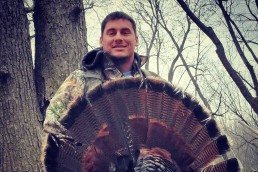Four Ways to Fill A Turkey Tag
SHARE THIS POST
If you’re like me, after several months of winter, spring is welcomed with open arms. For those of you who share with me turkey hunting as a passion, now is the time to start getting enthusiastic about the upcoming season. For those who haven’t, my hope is to get you excited to get out and try, because once you get your first glimpse of a big strutting tom, you understand the obsession we turkey hunters tend to have.
Just like there is more then one way to skin a cat, there are a plethora of ways to get after a turkey. In a perfect world, these will all work. But as a reality, you should use this article as a place to get started. Determining which one will work in the scenario you find yourself this spring will be up to you and is all part of the fun.
Stationary calling
This first method is probably the most obvious one. I use this method when taking my boys during youth season, or any other time I get the chance to take a younger kid. Essentially, you will have ideally scouted a place that contains good turkey sign, or will have seen turkeys in the area and can get in close to them without alerting the turkeys to your presence. Places that work well for this are short-cut flat fields, river or creek bottoms, and as close to roosting sites as possible without busting them. Look for feathers, tracks, leaves turned over and disturbed forest floors. These are places turkeys have been and may travel next to on a daily basis.
If you can get in and set up a blind, even better. This will help with concealment for children who like to fidget or eat snacks while waiting and will cover you while moving to make a shot. As I said before, this is a great beginner method or for someone not able to cover a lot of distance in the woods.
As with most things, however, there is a downfall, and that is the hunter is completely reliant on a bird passing through. Oftentimes, that involves a tom responding and moving towards your calling. Even if you are an expert caller, sometimes there is just no way that bird is going to close the entire distance to your blind. For this reason, my sons and I have had mediocre success, but it has worked on more than one occasion after some significant amount of patience.
The wake-up caller
The second method is an almost sure bet if you are able to pull it off. The key is finding a roost spot where a group of turkeys sleep overnight and sneaking in as close as you can before daylight. That way, you are set up and ready to call as soon as the turkeys come off the roost. If you’re lucky and have been diligent remaining silent and stealthy, the tom may fly down in the direction with some soft calls right at daylight.
Are you enjoying this post?
You can be among the first to get the latest info on where to go, what to use and how to use it!
This will work exceptionally well if you can accomplish what is known as “putting them to bed.” That entails listening to or witnessing them fly up in the trees before dusk; so long as they are not spooked, they will still be there the next morning. This method is great if you can accomplish locating a roost site.
Run-and-gun
This method is not quite as rambunctious as it sounds. The whole concept is to be mobile and remain reactive to what the turkeys are doing. This works best when the hunter has access to a large area of land and can identify at least a few eager, vocal toms. It is not a good idea when you are hunting an area where you will potentially have a lot of other hunters, such as public land or a crowded hunting lease. This is my go-to method when hunting solo and it has proven to be the most effective when all those factors align.
I’ll go into an area where I have scouted and know turkeys are there, and I’ll start out with a hoot owl or crow call well before daylight. When I locate the closest or most receptive turkey, I will sneak in and get as close as possible to the roost. Then, if he comes down interested, I’ll keep calling to see if he will come in. If one tom turns out unsuccessful or loses interest, I will locate the next closest and try from there. This will go on until I am either successful or to the end of legal shooting time. This can be a fun and exciting way to turkey hunt, but can certainly test how good of shape you’re in.
Bring on the chaos
The final method is perhaps one of the most unorthodox ways to hunt the mighty thunder chicken. This one will work great if you have become frustrated by toms which have already found hens and bunched up with them. If you are doing your most sultry hen calling and a gobbler is just not having it, then it might be time to get aggressive.
The method involves coming in fast or even running right through the group of turkeys (remember to keep safety first and foremost). They will get startled and scatter to the four winds, and when they do, you set up in a central location. The group will do their best to call out to each other and reassemble. Lightly mix your hen calls in with the real hens. If you have managed to get yourself in between a gobbler and a hen, you are in for an exciting hunt. This, of course, is sort of a last-ditch effort, but has proven to be effective for me on multiple occasions. Hang onto this method in your turkey toolbelt of tricks, because it can be a great way to be successful during the fall turkey season.
I hope these four methods of going after turkeys can give you an edge this season, and that with a little luck, you can be putting a turkey in the freezer for next Thanksgiving—or any occasion for that matter.
MWO
SHARE THIS POST
Did you enjoy this post?
You can be among the first to get the latest info on where to go, what to use and how to use it!
MWO
We believe being outdoors is good. With more than 1,000 articles each year, MidWest Outdoors magazine is all about sharing outdoor experiences with you—where to go, what to use and how to use it… whether you’re close to home or on that trip of a lifetime.



